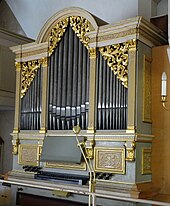Ringethal village church
The Protestant village church Ringethal is an originally Romanesque, later Gothic and Baroque hall church in the Ringethal district of Mittweida in the district of Central Saxony . It belongs to the parish Mittweida in the church district of Glauchau-Rochlitz of the Evangelical Lutheran regional church of Saxony and is best known for its organ, which is attributed to Gottfried Silbermann .
History and architecture
The originally Romanesque hall church, dating from the 12th century, underwent Gothic changes around 1490, such as the lengthening of the choir and the addition of a ridge turret. After 1742 a patronage box, galleries and large windows were installed. A restoration was carried out in 1884. In 1964 the interior was redesigned by relocating the organ gallery to the west and exposing a Gothic window. The church is a plastered quarry stone building with a retracted, just closed choir with additions such as a box, sacristy and an octagonal roof turret with a high helmet .
The small interior is closed off by a simple field ceiling and is characterized by the galleries on three sides, which are two-story on the north side. A Romanesque triumphal arch leads to the flat-roofed choir. A Gothic porphyry portal with framework is arranged on the north side of the choir, on the south side the gallery designed as a mansion box. The sacristy is closed by a barrel vault.
Furnishing
A simple block-like altar with consecration crosses dates back to the Middle Ages, the altar cross and the candlesticks are from the 18th century. The pillar-like sandstone baptism with an octagonal foot and a round cup was created around 1490. In the vestibule is another sandstone baptism from 1864, the octagonal cupa of which is decorated with tracery. A larger than life crucifix dates from the second half of the 13th century. A simple porphyry sacraments niche with a triangular end from around 1490 is attached to the east wall .
Several tombs from the 16th to 18th centuries are placed on the outside walls of the church, including that of a member of those von Hahn († 1601) with a full-length relief of a kneeling man in armor between Ionic pillars.
organ
The small organ is a work presumably from around 1725 with originally six stops on a manual and pedal . It is attributed to Gottfried Silbermann because of the (here slightly modified) characteristic style of his workshop. It was first mentioned in 1800 in a handwritten directory of Silbermann's works by Johann Gottfried Fischer (1751–1821) and was probably initially in the house of the Ringethal manor. It can be assumed that the organ was transferred to the church around 1762 due to the war and placed on a gallery above the altar.
In the years 1842/1843 the organ was equipped by Christlieb Ladegast with a further register and a pedal with pedal coupler and the register sub-bass 16 ′ and the fifth 1 1 ⁄ 3 ′ was placed in a lower pitch. Presumably the organ was tuned higher at that time and given the same temperature. During a cleaning in 1935 by the Jehmlich organ building workshop , the register added during the previous revision was removed again. In 1964/1966 the organ was moved to the west gallery by Reinhard Schmeisser and equipped with a new fan; the fifth was also returned to its original pitch. In 1995 a restoration was carried out by the company Eule Orgelbau Bautzen . The disposition is:
|
|
||||||||||||||||||||
- Pairing : I / P
- Remarks
- ↑ added later
- Technical specifications
- Wind pressure: 55 mm water column
- Grinding wind chest
- Action : mechanical
-
Mood :
- Pitch: a 1 = 439.2 Hz
- Type: equal
Peal
The ringing consists of three chilled cast iron bells , the bell frame and the bell yokes are made of steel or cast iron. Below is a data overview of the bell:
| No. | Casting date | Caster | material | diameter | Dimensions | Chime |
|---|---|---|---|---|---|---|
| 1 | 1955 | Bell foundry S. Schilling | Chilled iron | 890 mm | 450 kg | a ′ |
| 2 | 1955 | Bell foundry S. Schilling | Chilled iron | 742 mm | 260 kg | c ″ |
| 3 | 1955 | Bell foundry S. Schilling | Chilled iron | 654 mm | 175 kg | d ″ |
literature
- Georg Dehio : Handbook of the German art monuments. Saxony II. The administrative districts of Leipzig and Chemnitz. Deutscher Kunstverlag, Munich / Berlin 1998, ISBN 3-422-03048-4 , pp. 698–699.
- Rainer Thümmel : Bells in Saxony . Sound between heaven and earth. Ed .: Evangelical Regional Church Office of Saxony . 2nd, updated and supplemented edition. Evangelische Verlagsanstalt, Leipzig 2015, ISBN 978-3-374-02871-9 , p. 349 (With a foreword by Jochen Bohl and photographs by Klaus-Peter Meißner}).
Web links
- Parish website
- Ringethal - organ around 1725 on the website of the Gottfried Silbermann Society
Individual evidence
- ↑ Werner Müller: Gottfried Silbermann. Personality and work - a documentation. 1st edition. Deutscher Verlag für Musik, Leipzig 1982, p. 360.
- ↑ Frank-Harald Greß , Michael Lange: Die Orgeln Gottfried Silbermanns (= publications of the Society of Organ Friends. No. 177). 2nd Edition. Sandstein-Verlag, Dresden 2001, ISBN 3-930382-50-4 , p. 60.
- ^ A b Rainer Thümmel : Bells in Saxony . Sound between heaven and earth. Ed .: Evangelical Regional Church Office of Saxony . 2nd, updated and supplemented edition. Evangelische Verlagsanstalt, Leipzig 2015, ISBN 978-3-374-02871-9 , pp. 349 (With a foreword by Jochen Bohl and photographs by Klaus-Peter Meißner).
Coordinates: 51 ° 0 ′ 20.2 " N , 12 ° 59 ′ 56.6" E



